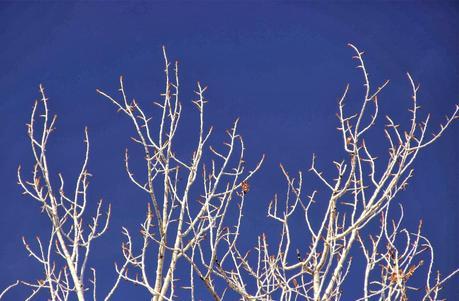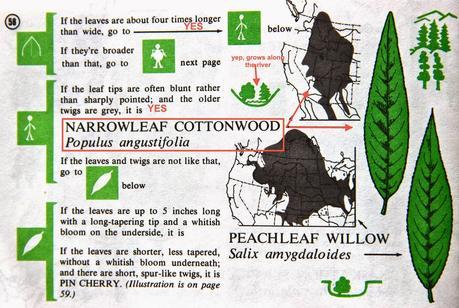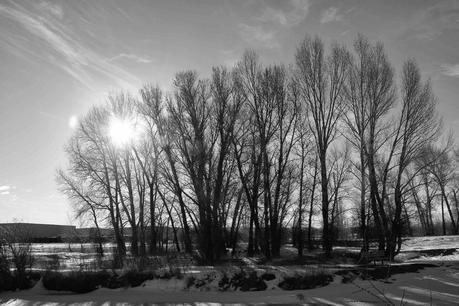 Lucy of Loose and Leafy has stepped up her efforts to organize and encourage tree-followers. This is very kind, as tree-following is always interesting and it's fun to share discoveries. We choose a tree to follow through the year, and there's so much to learn. What kind is it and how do we know? When do leaves appear? flowers, fruit? Who lives there? How does it catch the sunrise? Does it do justice to the golden hour just before sunset? These are all important things, and it’s our responsibility to find out.
Lucy of Loose and Leafy has stepped up her efforts to organize and encourage tree-followers. This is very kind, as tree-following is always interesting and it's fun to share discoveries. We choose a tree to follow through the year, and there's so much to learn. What kind is it and how do we know? When do leaves appear? flowers, fruit? Who lives there? How does it catch the sunrise? Does it do justice to the golden hour just before sunset? These are all important things, and it’s our responsibility to find out.Stirred by Lucy’s enthusiasm, I took my camera with me on my morning walk along the Laramie River. It’s still winter here, so I got side-tracked by the beauty of river ice.

Center foreground -- our tracks from last week, now inverted because most of the snow has blown away.

Footbridge across the river, once a railroad bridge.

Shadow patterns cast by grass, brush and trees.

My field companion, as faithful to me as his shadow is to him.
I returned to my mission and soon chose a tree for 2014 (below left). Or maybe I should say “trees” as there are multiple trunks. Most of the trees along the river grow this way, in clumps. Is this a single individual, connected underground? Winter landscapes can seem so dreary. But if we can get out of that black-and-white mode caused by snow, we realize there's quite a bit of color after all.
Winter landscapes can seem so dreary. But if we can get out of that black-and-white mode caused by snow, we realize there's quite a bit of color after all.

Another view -- the tree stands over its cousins, the willows.

Its twigs appear bare at first glance. A closer look (click on image) reveals buds ready for spring.
 Trees often are challenging to identify without leaves, but I gave it a shot. I ran a dead leaf through the Rocky Mountain Tree Finder, partly because I love dichotomous keys and this one is so easy to use. How does it work? At each step I pick one of two choices, thereby eliminating a substantial number of tree species from consideration. I continue this way until the only one left is the one I’m standing under! It seems like magic, even after all these years.
Trees often are challenging to identify without leaves, but I gave it a shot. I ran a dead leaf through the Rocky Mountain Tree Finder, partly because I love dichotomous keys and this one is so easy to use. How does it work? At each step I pick one of two choices, thereby eliminating a substantial number of tree species from consideration. I continue this way until the only one left is the one I’m standing under! It seems like magic, even after all these years. In this case, the path to identification required 14 steps, including the following:
In this case, the path to identification required 14 steps, including the following:1) Leaves needle or scale-like OR ordinary? ordinary
2) Leaves compound, composed of several leaflets OR simple? simple
3) Leaves paired on opposite sides of twigs OR not? not (no leaves, so checked leaf scars)
4) Leaves lobed OR not? not
5) Leaf stalks (petioles) longer than 1 inch OR less than? less than
... etc. ...
10) Leaf margin with big & little teeth OR single-sized teeth? single-sized

Leaf margin with single-sized teeth.
and finally:14) Leaf tips often blunt rather than sharply pointed OR not? often blunt rather than sharply pointed (see illustrations below)It appears to be the narrowleaf cottonwood, Populus angustifolia (click on image for more information).

 I also attempted to identify the tree with the Winter Tree Finder. This is challenging because the useful characters are harder to see and not as familiar. I had to look at terminal buds, leaf scars and vein scars -- so let’s digress.
I also attempted to identify the tree with the Winter Tree Finder. This is challenging because the useful characters are harder to see and not as familiar. I had to look at terminal buds, leaf scars and vein scars -- so let’s digress.
From the Winter Tree Finder.
The terminal bud is where the twig will start the year's growth. Leaf scars are left when leaves fall off. They contain vein scars -- remnants of conduits (phloem, xylem) for transporting water, nutrients, carbohydrates and more.Now back to identification. I went straight to the cottonwood section. The Winter Tree Finder says terminal buds of cottonwoods are symmetrical. According to the Audubon Society's Field Guide to North American Trees, Western Region, terminal buds of the narrowleaf cottonwood are resinous and smell of balsam. Let’s look:

The terminal bud is indeed symmetrical, and somewhat resinous too. I didn't detect a balsam odor.
The Winter Tree Finder says leaf scars of cottonwoods are crescent-shaped with three vein scars. Sure enough, there are three vein scars on each crescent-shaped leaf scar:
The leaf scar below the bud is from last year; the one near the base of the twig is probably two years old.
The terminal buds, leaf scars, and vein scars of my tree all match those of cottonwoods. But I couldn’t go any further in the Winter Tree Finder because it covers the eastern USA, and Wyoming is in the west.I'm sure this is a cottonwood and probably a narrowleaf cottonwood. The bark looks right: “smooth, becoming gray-brown and furrowed into flat ridges at the base” (Audubon Society Field Guide to North American Trees, Western Region). It's growing in the right kind of habitat -- lowlands or near water -- and well within its range (see previous map). I will check my tentative identification after the tree leafs out, but first it will bloom and I'll need to investigate that as well. Cottonwoods have unisexual flowers, either male or female, and the sexes are on separate trees (dioecious). Thus I’ll learn whether this clump is male or female -- or maybe both, suggesting these are separate trees after all.
I will check my tentative identification after the tree leafs out, but first it will bloom and I'll need to investigate that as well. Cottonwoods have unisexual flowers, either male or female, and the sexes are on separate trees (dioecious). Thus I’ll learn whether this clump is male or female -- or maybe both, suggesting these are separate trees after all.
Cottonwoods along the Laramie River, in winter morning sun.
However I shouldn't dwell on tree activity right now. It's only February. Cottonwood flowers and leaves won't appear for months yet, probably in May, at least that's what I think I remember. I don't always notice -- but this year I will.Are you following a tree? Sign up here to join the fun.
